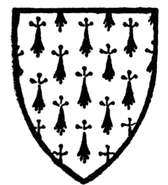The Language of Heraldry part 3
 The rules of Heraldry prohibit placing a color on a color, a metal upon a metal or, a fur upon a fur. There is one well known exception to the rule about metals and this is on the well known arms for the kingdom of Jerusalem, where the gold cross and crosses are placed on a silver field. On the basis of these three materials, Color, Metal and fur all coats of arms are created. The items placed on the field are called charges. The original shields were very simple with few charges as there were very few knights and nobleman that had arms. However as Coats of Arms became more widespread the need to differentiate arms led to the addition of more and more charges to the shield.
The rules of Heraldry prohibit placing a color on a color, a metal upon a metal or, a fur upon a fur. There is one well known exception to the rule about metals and this is on the well known arms for the kingdom of Jerusalem, where the gold cross and crosses are placed on a silver field. On the basis of these three materials, Color, Metal and fur all coats of arms are created. The items placed on the field are called charges. The original shields were very simple with few charges as there were very few knights and nobleman that had arms. However as Coats of Arms became more widespread the need to differentiate arms led to the addition of more and more charges to the shield.
The earliest charges were such things as bends ( diagonal lines), Chevrons (inverted v’s), chiefs (band across top of shield), piles ( v shape), fesses (horizontal lines) and crosses. These charges would naturally suggest themselves to the early users. For example, Azure a bend argent ( blue background with a silver diagonal line). This was a very easy design for a coat of arms. Generally speaking the simpler a coat of arms is the further back it can be dated. Many writers have asserted that every coat of arms must consist of at least the field and a charge, however there are a number of exceptions to this, The Brittany arms which are simply “Ermine”.

A plain shield of Ermine ( above ) was borne by John of Brittany, Earl of Richmond who died in 1399. Additional examples of a single field shield include: A plain shield of Gold was borne by the Italian family of Bandinelli,, of Silver by the French families of Maigret and Bocquet, of Blue by the French family Fizeaux, of Red by the House of Dalbret borne by the kings of Navarre, Spain, and Black by the family of Gornay. A plain Green shield is borne by the French family Barbotte and Purple by the French family Aubert.












